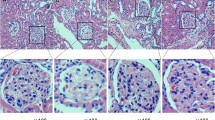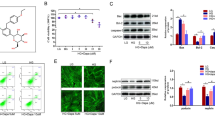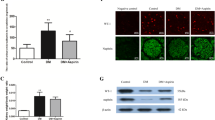Abstract
Background and aims
The objective of this study is to observe the effect of alpha-lipoic acid (ALA) on Pod injury by anti-inflammation and explore its possible renal protective mechanism.
Methods
A total of 36 cases with type 2 diabetes with microalbuminuria and fasting plasma glucose (FPG) levels less than 9 mmol/L and glycated hemoglobin A1c (HbA1c) ≤9.0 % were recruited to be treated with ALA (600 mg, daily) for 6 months (group DA). Another 30 healthy individuals were chosen as normal controls (group NC). The levels of serum creatinine (Cr), FPG, and HbA1c were detected; blood pressure was recorded; and early morning urine samples (corrected for urinary Cr) were collected for the examination of urinary monocyte chemoattractant protein-1 (MCP-1), transforming growth factor-β1 (TGF-β1), podocalyxin (PCX), nephrin, albumin and Cr in group NC and group DA at the baseline and the sixth month.
Results
The excretions of urinary MCP-1, TGF-β1, PCX, nephrin and albumin to Cr ratio (abbreviated as UMCR, UTCR, UPCR, UNCR and UACR respectively) were significantly increased in group DA compared with group NC (all P < 0.01), and after 6-month treatment, all indexes mentioned above decreased markedly (P < 0.05), while FPG and HbA1c had no obvious changes. Additionally, there was a positive correlation between UMCR, UTCR with UPCR, UNCR and UACR, respectively (all P < 0.01).
Conclusions
Anti-inflammation of ALA in vivo and local kidney is implicated in the protection of glomerular Pod injury in patients with type 2 diabetes.


Similar content being viewed by others
References
Navarro González JF, Mora Fernández C (2008) The role of inflammatory cytokines in diabetic nephropathy. J Am Soc Nephrol 19(3):433–442
Wu CC, Sytwu HK, Lin YF (2012) Cytokines in diabetic nephropathy. Adv Clin Chem 56:55–74
Ibrahim S, Rashed L (2008) Correlation of urinary monocyte chemo-attractant protein-1 with other parameters of renal injury in type-II diabetes mellitus. Saudi J Kidney Dis Transpl 19(6):911–917
Ka SM, Yeh YC, Huang XR, Chao TK, Hung YJ, Yu CP et al (2012) Kidney-targeting Smad7 gene transfer inhibits renal TGF-β/MAD homologue (SMAD) and nuclear factor-κB (NF-κB) signalling pathways, and improves diabetic nephropathy in mice. Diabetologia 55(2):509–519
Lee HS (2012) Mechanisms and consequences of TGF-ß overexpression by podocytes in progressive podocyte disease. Cell Tissue Res 347(1):129–140
Okamura K, Dummer P, Kopp J, Qiu L, Levi M, Faubel S et al (2013) Endocytosis of albumin by podocytes elicits an inflammatory response and induces apoptotic cell death. PLoS ONE 8(1):e54817
Campbell KN, Raij L, Mundel P (2011) Review role of angiotensin II in the development of nephropathy and podocytopathy of diabetes. Curr Diabetes Rev 7(1):3–7
Mathieson PW (2009) Review update on the podocyte. Curr Opin Nephrol Hypertens 18(3):206–211
Tarabra E, Giunti S, Barutta F, Salvidio G, Burt D, Deferrari G et al (2009) Effect of the monocyte chemoattractant protein-1/CC chemokine receptor 2 system on nephrin expression in streptozotocin-treated mice and human cultured podocytes. Diabetes 58(9):2109–2118
Habara P, Marecková H, Sopková Z, Malícková K, Zivorová D, Zima T et al (2008) A novel method for the estimation of podocyte injury: podocalyxin-positive elements in urine. Folia Biol (Praha) 54(5):162–167
Zheng M, Lv LL, Ni J, Ni HF, Li Q, Ma KL et al (2011) Urinary podocyte-associated mRNA profile in various stages of diabetic nephropathy. PLoS ONE 6(5):e20431
Mihai B, Lăcătuşu C, Graur M, Cijevschi-Prelipcean C, Mihai C (2010) Pharmacologic therapy in peripheral diabetic polyneuropathy. Rev Med Chir Soc Med Nat Iasi 114:332–341
Yi X, Nickeleit V, James LR, Maeda N (2011) α-Lipoic acid protects diabetic apolipoprotein E-deficient mice from nephropathy. J Diabetes Complicat 25(3):193–201
Niranjan T, Bielesz B, Gruenwald A, Ponda MP, Kopp JB, Thomas DB et al (2008) The Notch pathway in podocytes plays a role in the development of glomerular disease. Nat Med 14(3):290–298
Yu L, Lin Q, Feng J, Dong X, Chen W, Liu Q et al (2013) Inhibition of nephrin activation by c-mip through Csk-Cbp-Fyn axis plays a critical role in Angiotensin II-induced podocyte damage. Cell Signal 25(3):581–588
Kobayashi T, Notoya M, Shinosaki T, Kurihara H (2009) Cortactin interacts with podocalyxin and mediates morphological change of podocytes through its phosphorylation. Nephron Exp Nephrol 113(3):e89–e96
Keith Dove J, Butler Judy A, Bemer Brett, Dixon Brian, Johnson Shawn, Garrard Mary et al (2012) Age and gender dependent bioavailability of R- and R, S-α-lipoic acid: a pilot study. Pharmacol Res 66:199–206
Tesch GH (2008) MCP-1/CCL2: a new diagnostic marker and therapeutic target for progressive renal injury in diabetic nephropathy. Am J Physiol Renal Physiol 294(4):F697–F701
Winiarska K, Malinska D, Szymanski K, Dudziak M, Bryla J (2008) Lipoic acid ameliorates oxidative stress and renal injury in alloxan diabetic rabbits. Biochimie 90:450–459
Kang KP, Kim DH, Jung YJ, Lee AS, Lee S, Lee SY et al (2009) Alpha-lipoic acid attenuates cisplatin-induced acute kidney injury in mice by suppressing renal inflammation. Nephrol Dial Transplant 24(10):3012–3020
Lee EY, Chung CH, Khoury CC, Yeo TK, Pyagay PE, Wang A et al (2009) The monocyte chemoattractant protein-1/CCR2 loop, inducible by TGF-beta, increases podocyte motility and albumin permeability. Am J Physiol Renal Physiol 297(1):F85–F94
Hohenstein B, Daniel C, Hausknecht B, Boehmer K, Riess R, Amann KU et al (2008) Correlation of enhanced thrombospondin-1 expression, TGF-beta signalling and proteinuria in human type-2 diabeticnephropathy. Nephrol Dial Transplant 23(12):3880–3887
Lee HS, Song CY (2010) TGF-beta on podocytegrowth and disease progression in proliferativepodocytopathies. Kidney Blood Press Res 33(1):24–29
López-Hernández FJ, López-Novoa JM (2012) Role of TGF-β in chronic kidney disease: an integration of tubular, glomerular and vascular effects. Cell Tissue Res 347(1):141–154
Nam BY, Paeng J, do Kim SH, Lee SH, Kim H, Kang HY et al (2012) MCP-1/CCR2 axis in podocytes is involved in apoptosis induced by diabetic conditions. Apoptosis 17(1):1–13
Eyre J, Burton JO, Saleem MA, Mathieson PW, Topham PS, Brunskill NJ (2011) Monocyte- and endothelial-derived microparticles induce an inflammatory phenotype in human podocytes. Nephron Exp Nephrol 119(3):e58–e66
Andreasen AS, Kelly M, Berg RM, MØller K, Pedersen BK (2011) Type 2 diabetes is associated with altered NF-κB DNA binding activity, JNK phosphorylation, and AMPK phosphorylation in skeletal muscle after LPS. PLoS ONE 6(9):e23999
Ohga S, Shikata K, Yozai K, Okada S, Ogawa D, Usui H et al (2007) Thiazolidinedione ameliorates renal injury in experimental diabetic rats through anti-inflammatory effects mediated by inhibition of NF-B activation. Am J Physiol Renal Physiol 292(4):F1141–F1150
Gorąca A, Huk Kolega H, Piechota A, Kleniewska P, Ciejka E, Skibska B (2011) Lipoic acid—biological activity and therapeutic potential. Pharmacol Rep 63(4):849–858
Niranjan T, Bielesz B, Gruenwald A, Ponda MP, Kopp JB, Thomas DB et al (2008) The Notch pathway in podocytes plays a role in the development of glomerular disease. Nat Med 14(3):290–298
Fiorentino L, Cavalera M, Menini S, Marchetti V, Mavilio M, Fabrizi M et al (2013) Loss of TIMP3 underlies diabetic nephropathy via FoxO1/STAT1 interplay. EMBO Mol Med 5(3):441–455
Bollee G, Flamant M, Schordan S, Fligny C, Rumpel E, Milon M et al (2011) Epidermal growth factor receptor promotes glomerular injury and renal failure in rapidly progressive crescentic glomerulonephritis. 17:1242–1250
Uchigata Yasuko, Hirata Yukimasa, Iwamoto Yasuhiko (2010) Insulin autoimmune syndrome (Hirata disease): epidemiology in Asia, including Japan. Diabetol Int 1:21–25
Furukawa N, Miyamura N, Nishida K, Motoshima H, Taketa K, Araki E (2007) Possible relevance of alpha lipoic acid contained in a health supplement in a case of insulin autoimmune syndrome. Diabetes Res Clin Pract 75:366–367
Acknowledgments
This research was supported by the natural science foundation (No. 11040606M159) and natural science research project (No. KJ2011A157) of Anhui Province of China. Great help was offered by the Department of Endocrinology of Anhui Provincial Hospital affiliated to Anhui Medical University of China.
Conflict of interest
The authors state that they have no conflict of interest.
Author information
Authors and Affiliations
Corresponding author
Rights and permissions
About this article
Cite this article
Bao, XH., Xu, J., Chen, Y. et al. Alleviation of podocyte injury: the possible pathway implicated in anti-inflammation of alpha-lipoic acid in type 2 diabetics. Aging Clin Exp Res 26, 483–489 (2014). https://doi.org/10.1007/s40520-014-0207-1
Received:
Accepted:
Published:
Issue Date:
DOI: https://doi.org/10.1007/s40520-014-0207-1




